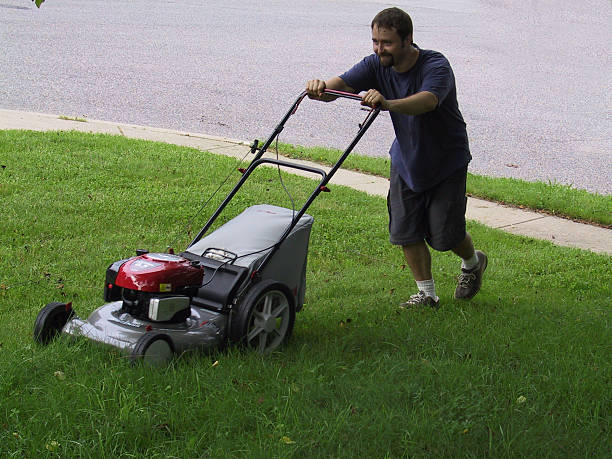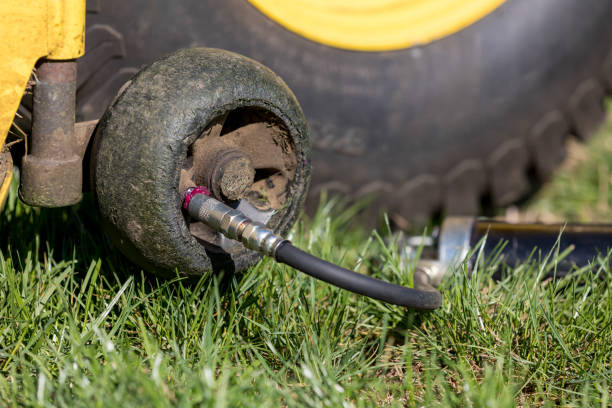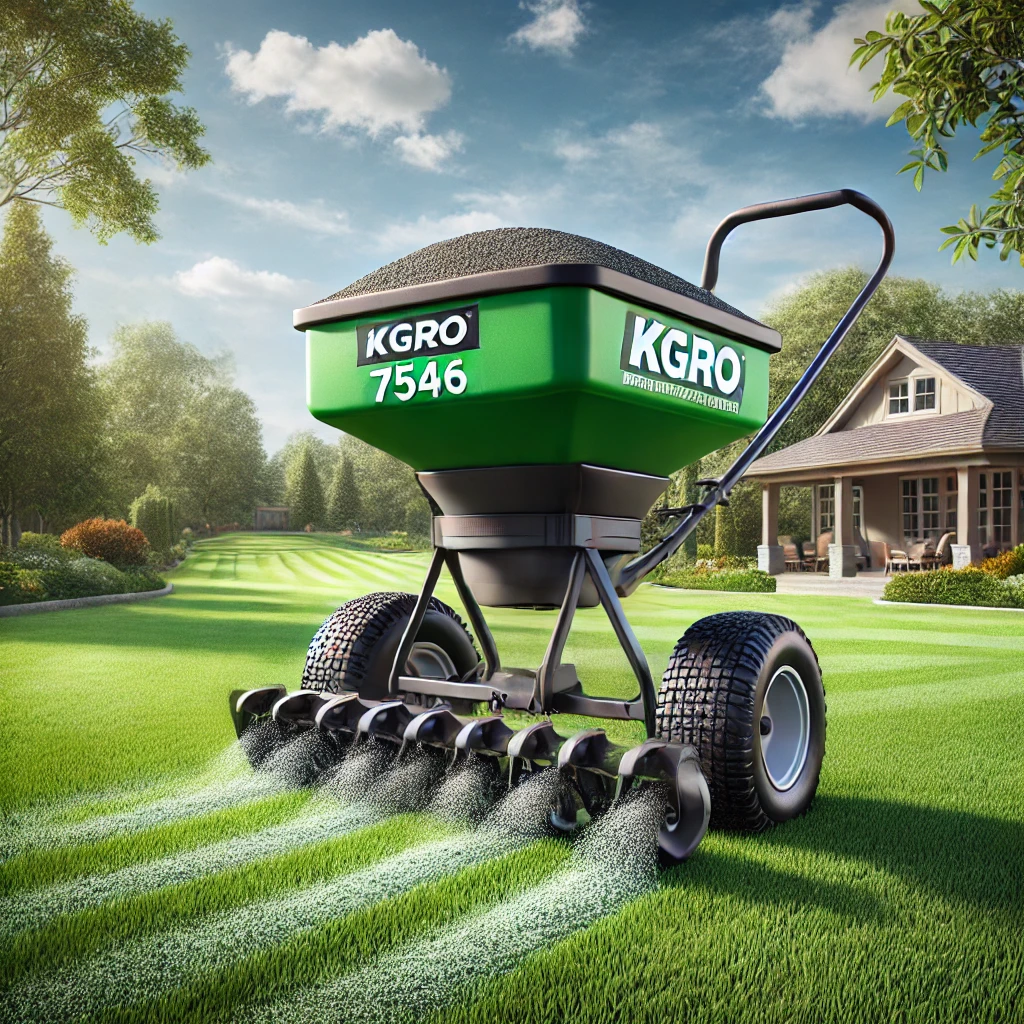Introduction
It is important to have the correct lawn mower height because it keeps your garden healthy and beautiful. The level at which you trim your yard has an enormous impact not only on how well it looks but also on its overall health and ability to withstand things such as droughts, pests, and diseases. Mowing too low will help ensure that the grass grows deep roots—a critical factor for strong and lush lawns.
Various factors should be considered when adjusting heights on mowers, like the type of grass being grown since different varieties require specific ranges to thrive best; seasons—during hot weather months more moisture is needed, therefore higher cuts are necessary, for example; etcetera. All these contribute towards finding out what the most appropriate cutting height is that will keep your garden healthy while at the same time making it look appealing.
What Are Lawn Mower Height Settings?
Lawn mower height settings refer to the adjustable options found in all lawn mowers, which allow one to control how close they want their blades to cut towards ground level. This setting is very important in landscape care because, depending on this number, one can easily determine the length of each blade after it is cut, thus affecting the growth rate as well as the general outlook of turf grasses.
Different types of mowers have various ways of adjusting heights.
Push mowers are best suited for small yards; they usually have levers on each wheel or just one central lever that can raise or lower them simultaneously until the desired height is reached.
Riding mowers are mainly used by farmers who own large fields; these machines come equipped with knobs located beside the driver’s seat, which, when turned clockwise, raise all cutters at once while anti-clockwise motion does the opposite, thereby giving evenness over wider areas.
Robotic mowers are relatively new technology; some brands allow users to set them up digitally through smartphones. This makes it easy for people to change whenever there is a necessity without much struggle involved.

Seasonal changes may also require different settings. For example, during springtime, moderate cutting heights should be observed as this strengthens roots, but as summer comes and temperatures go up, one has to increase mowing levels so that the lawn is not starved of moisture, which can lead to it drying out quickly. It is important to make these alterations if you want your yard to remain healthy throughout the year.
Advantages of the Correct Height Settings
The following are some of the benefits associated with having the right measurements on lawnmowers:
Improving Grass Health and the Development of Roots:
When you cut grass at appropriate heights, more robust, deep-rooted systems are encouraged. This allows them to access water and nutrients better, which promotes good growth as well as resistance to various environmental challenges.
Cutting very low causes an energy imbalance in plants whereby most resources are used up during blade regeneration instead of focusing on strengthening its underground parts, hence making it vulnerable to different kinds of stressors.
Prevention of Lawn Diseases
Setting the mower at the right height significantly minimizes the chances of diseases and insect infestations in your lawn. Taller grass leaves shade the soil, which helps prevent moisture loss and stops many weed seeds from germinating as well.
Moreover, a maintained height inhibits fungi and other pathogens that grow on damaged or stressed grasses. Pest activity is also minimized when turf is cut to its preferred height because its robustness enables it to resist more attacks by pests while recovering quickly from such damages.
Improving the Beauty of Your Lawn
Visually, a yard mowed too low tends to appear thin and brownish rather than lush green. The saved look that comes with cutting lawns very short all over them gives an ugly appearance where some areas have a few strands sticking up above ground level like somebody who has been scalped.
The uniformity of length throughout your whole garden also adds to its attractiveness, making it look neatly cared for, inviting, etc. This not only increases people’s satisfaction levels within themselves while outside their homes but can even raise values attached thereto in terms of curb appeal or general outlook on residential properties vis-à-vis other neighboring houses, estates around town, etcetera, too far away places if you are considering letting out rooms there during holiday seasons, especially those involving tourists from different parts of the world.
Cutting Cool Season Grasses (North of St. Louis)

In regions northward of St. Louis, Kentucky, bluegrass, fescue, and ryegrass are among the most commonly grown cool-season grasses, which consist mainly of the northern part of the United States. These types tend to grow most vigorously during the spring and fall months when temperatures cool down. Here’s how to best mow these grasses:
Ideal Mowing Height: Maintain cutting heights between 2½ and 3½ inches. This helps foster the deep rooting systems necessary for absorbing water nutrients, especially in dry and cold periods.
Mowing Frequency: During peak times, growth such as spring and fall weeks apart would be required normally every five days, although it could be more or less depending on the rate at which they sprowerut due to weather patterns that may prevail there.
Adjustments Per Season: To keep moisture within heat seasons raise your mower blade during summer Lowering snow mold prevention can also happen by bringing down blades slightly late into autumn for a second last cut before winter sets in.
Cutting Warm Season Grasses (South of St. Louis)
Further southwards from where you might reside if located anywhere around St. Louis, such areas would have slightly different grass types, being warm-season ones like Bermuda Zoysia Augustine, etc., characterized by thriving well under hot weather conditions but going dormant throughout the colder months. Here’s what needs to be done when dealing with these turf varieties:
Ideal Mowing Height: For the most part, warm-season varieties should be kept shorter, ranging between 1 and 2½ inches. However, there are some exceptions, one being that Bermuda grass can go lower while St. Augustine should stay on the higher end of the range
Mowing Frequency: During periods of active growth from late spring through summer, you may need to increase the number of times per month, perhaps every five days, as they tend to grow faster in particularly warm places with high levels of humidity and temperature, together with adequate sunlight supply all year round.
Seasonal Adjustments: At the beginning of the season, reduce dead tops, green up, and increase height during maximum temperatures to conserve water.
Before altering the height of your mower, ensure that you have everything you need. This usually includes:
A wrench or socket set for turning bolts or levers
A tape measure for accurate blade height checking
Safety gloves
Prepare your mower by parking it on a flat surface and turning it off. For gas mowers, disconnect the spark plug to prevent accidental starting.
Step-by-Step Instructions for Different Mower Types

Push mowers: Look near the wheels for an adjustment lever. Most push mowers have one lever at each wheel or a central system that adjusts all wheels at once. Lift the lever and slide it to the desired height setting; make sure it clicks into place.
Riding mowers: Locate the height adjustment lever, which is often near the seat or steering panel. Move this lever to your preferred setting; all blades will be adjusted together so they cut at an even height.
Robotic Mowers: Digital models typically feature adjustments through an app or on-mower display panel. Choose your desired height, and the mower will do the rest.
Tips for Even Adjustment Across the Mower Deck
Measure from ground to blade tip at multiple spots along the deck after adjusting to ensure evenness. If there are any imbalances, adjust again as needed.
Regularly check and lubricate the adjustment mechanism for smooth operation.
How grass type affects mowing height
Different types of grasses have different growth habits and ideal cutting heights based on those behaviors. Here’s what you should know about how grass type affects recommended mowing heights:
Cool-season grasses like Kentucky bluegrass, fescue, and ryegrass perform best when kept between 2 1/2 and 4 inches tall. These species grow most actively during spring and fall, so adjusting mower height throughout the year can help promote strong growth and root development during these periods.
Warm-season grasses such as Bermuda grass, Zoysia grass, and St. Augustine grass prefer to be cut shorter, usually between 1 and 2 1/2 inches tall. These grasses are most active in warm summer weather, and lower cutting height promotes a tidier appearance while encouraging sideways spread.
Knowing what kind of turf you have will enable you to adjust your mowing accordingly for the best results in terms of the health and appearance of your lawn.
How short is it to cut grass in spring?

Spring is a time of rapid growth for lawns as temperatures rise and daylight lengthens. Here’s how low you should go when cutting grass during this period:
Cool-season grasses: In spring, target heights range from 3 to 4 inches for cool-season varieties. This will keep them strong enough to withstand potential stresses like temperature fluctuations or heavy rains. Avoid removing more than one-third of the total blade length at any single mowing; doing so can shock the plant and slow down its progress.
Warm-season grasses: For these types, shave off about half their usual height during early spring—around 1.5–2.5 inches. That will stimulate greening up and thickening as soon as warmth returns, but before hot spells come back again later on in the season.
So the same rule applies here too: never take off over the third total leaf sheath per session, or else risk inhibiting further growth altogether next time around!
These recommendations should help keep your turf healthy through the spring months so it can flourish during the summer.
Common Mistakes to Avoid
Cutting the grass too briefly and scaling
Do not set your mower too low because this will cause scalping, where the mower cuts the grass so short that it injures the crown of the plant. This weakens the grass and may result in patches without any growth, making your lawn more susceptible to weeds and diseases.
Ignoring uneven ground and obstacles
Watch out for uneven ground or obstacles like rocks, roots, or bumps. They can affect mowing height and damage your mower. Change your mowing path or height as necessary to get past these hazards safely.
Failing to Adapt to Seasons
Grass requirements change throughout the year, so you should adjust your mowing heights accordingly. For example, during hot summer months, it is recommended that you keep a higher cut to help retain moisture in the grass. Conversely, a lower height might be appropriate for cooler spring growth periods, promoting density.
By following these rules and avoiding common mistakes, you can have a healthy-looking yard all year.
Advanced Tips for Different Grass Types
Cool-Season vs. Warm-Season Grasses Recommendations
Cool-Season Grasses: Such as Kentucky bluegrass or fescue, which prefer colder temperatures during the fall and spring seasons when they are most active, these types typically need taller cuts (around 2.5–3.5 inches) so their roots go deep, allowing them to withstand freezing dry conditions.
Warm-Season Grasses: Bermuda, Zoysia, zoysia, etc. perform well under hotter weather conditions; hence, they should be cut shorter (about 1–2.5 inches) to spread easily, thus keeping dense cover, which helps cope with heat.
Special Care for Specific Areas of Your Lawn
Shaded Areas: Mow slightly higher than usual where there is shade because longer blades have more surface area for photosynthesis, which is important under low light intensities.
High Traffic Zones: The parts of your lawn that receive much foot traffic should be cut higher than the rest to encourage growth and strength, thus enabling recovery from trampling faster.
Maintaining lawn mower blades
Significance of Sharpness when Setting Effective Height
With a sharp blade, it cuts clean, which heals quickly and makes it less susceptible to diseases. When dull, they tear through, creating rough edges that stress the plant, making it vulnerable to disease-causing agents and also looking untidy.
Checking and sharpening mower blades
Check for sharpness: Look at them closely to see if there are any nicks or bends, or just simply if they appear blunt; alternatively, you could observe the quality of cut produced by your mower on grass; if tips are frayed, then it’s time to sharpen them up.
Sharpening Blades: There are several ways one can sharpen these tools, like using a file bench grinder, among others. While some may prefer taking theirs for professional help, in case you decide to do it yourself make sure the blade is balanced; otherwise, the machine will vibrate, leading to damage.
When Replacement Should Be Considered
Replace blades showing signs of severe wear, i.e., big nicks, bends, cracks, etc. Normally, every one-to-two years is recommended; however, this may vary with the type of grass being cut, among other factors.
The importance of regularly sharpening the blades of your mower cannot be overemphasized, as this is instrumental in ensuring a healthy lawn and the efficient operation of the machine. This will also help keep your desired height settings effective while contributing to the beauty of your well-kept yard.
What Is the Right Height To Cut New Grass?
When it comes to mowing new grass, you should first confirm that it has grown strong enough to withstand being cut off. Most frequently, though, this kind of grass should not be trimmed until it attains three inches in height. With few exceptions, this applies to almost all types of grasses since it enables young leaf blades to develop robust root systems before subjecting them to stress caused by initial mowing.
What Should Be Done When Cutting New Grass?
Wait Until It Grows to the Right Size: Allow new grass to grow up until at least 3 inches before mowing may begin; however, some species might require an additional half inch, such as 3.5 inches, for example.
Choose a Sharp Blade: Make sure that the cutting edges on your mower are sharp so that they give a neat slice, thereby preventing harm or infection.
Do Not Overdo It: Avoid taking down more than a third of any single turf shoot during one round of cuttings; otherwise, if done too short too soon, it could weaken newly planted lawns and hamper establishment below ground level.
Dry Weather Mowing: Only undertake mowings on dry days when dealing with juvenile plants because wet soil can cause tender roots to be ripped out by traction.













Leave a Reply